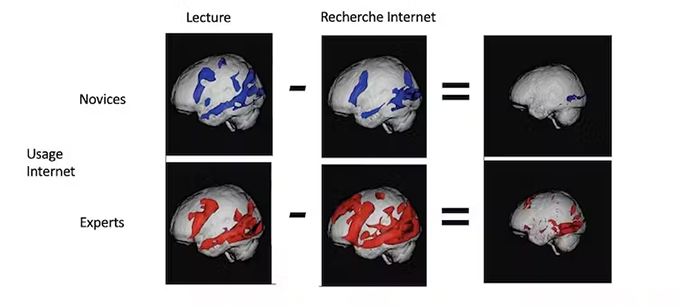 From papyrus to paper, via parchment and now arriving on screens, reading materials have evolved over time and continue to diversify in a society that is becoming increasingly digital. From smartphones to tablets or e-readers, writing is at the heart of our daily activities and our reading habits are changing.
From papyrus to paper, via parchment and now arriving on screens, reading materials have evolved over time and continue to diversify in a society that is becoming increasingly digital. From smartphones to tablets or e-readers, writing is at the heart of our daily activities and our reading habits are changing.
The rapid evolutions of these digital tools invite us to question the way in which we learn to read today and to wonder whether the use of new media modifies our ability to understand, which can be defined as the activity by which individuals will acquire and use knowledge. Complex and dynamic, it involves different sources of information.
The mechanics of text comprehension
Understanding involves developing a representation based on an interpretation of textual information related to our prior knowledge. Kintsch & van Dijk’s text comprehension model formalizes three levels of representation:
- the first, surface level, corresponds to our ability to remember a word read in the text, without the meaning being taken into account;
- the second level corresponds to the integration of the meaning of the sentences independently;
- finally, the third level, called the situation model, accounts for the reader’s ability to develop a representation which is the product of the interaction between what he reads and his prior knowledge. It is the ability to produce inferences.
Let’s take an example to understand what these inferences are. Imagine that you had to answer the question “Where are Anaïs and Julien? in the following text: “Saturday, Anaïs and Julien saw lions and tigers”. The first inference that emerges from reading this sentence through our knowledge is most likely the zoo. Now let’s add the sentence “Then the clown made them laugh a lot”. The inference produced following the reading of the initial sentence must be inhibited, in favor of a new inference situating our two protagonists probably in the circus. Let’s now conclude the text with the sentence “Mom then asked them to turn off the television to go to bed”. Here again, a new inference is set up: they were at home all along.
Understanding therefore presupposes the implementation of different cognitive processing in parallel: memory, mental flexibility, updating of information, inhibition.
Scrolling fatigue
Generally speaking, we can intuitively consider that reading on a screen or on paper does not modify our ability to understand a text: regardless of the medium, it is always a question of decoding graphic signs in order to attribute a meaning to them. However, reading on screen supposes taking into consideration the ergonomic characteristics of the reading supports (size, luminosity, contrast, etc.) and the characteristics of the reader.
A recent meta-analysis that compiles the results of 44 studies conducted with more than 170,000 participants on the effects of digital technology on reading tells us that, overall, comprehension is negatively impacted by reading on digital media compared to reading on paper. Studies do not make it possible to identify any difference between the two media in terms of comprehension in the case where full-page texts are consulted (without scrolling the text).
Indeed, when we read on screen, we use a process of “scrolling” which consists of vertically scrolling the text, which is not without consequence on our ability to understand the information read. It is very difficult to find information, a word or a sentence, after having scrolled through the text: the words no longer appear in the same place whereas, on paper, their spatial position does not change. Scrolling disrupts the functioning of our spatial memory. Locating the position of words in the text (spatial coding of words) is particularly useful for quickly returning to the words of the text, an essential process for comprehension.
On the other hand, the backlighting of the screens on which we read, which involves the projection of a light source towards the user, is not without consequence on our ability to read information. Several studies have shown its harmful effect on reading.
The ability to take in visual information is reduced on screen and requires more eye fixations when reading texts. This results in increased visual fatigue, associated with various symptoms (headaches, chronic migraines, etc.), especially when reading activity is prolonged or performed on poor quality interfaces (with poor contrast between background and color , reduced line spacing increasing visual clutter). These deleterious effects are not listed on the readers, which are not backlit but have electronic ink.
On the Internet, a superficial reading?
For the adult reader, reading is an automatic and rapid activity because the systematic learning of the correspondence between graphemes (letters, groups of letters) and phonemes (sounds) and the development of the mental lexicon make it possible in particular to free up cognitive resources. necessary for the implementation of the comprehension process. Our reading speed varies depending on the reading goal we have set for ourselves.
When we browse web pages, we read information-rich pages, conveying sometimes very short and dynamic messages intended to be more accessible in terms of quantity of content and therefore speed of reading. This gives a superficial side to the reading, which becomes skimming.
This superficial reading corresponds more to a search for information than to an in-depth reading aimed at understanding a concept, for example. Attention is disturbed in particular by the presence of multiple windows, the appearance of notifications, the presence of hypertext links which will allow us to navigate but will also contribute to disorienting us in the face of the consequent flow of information present.
A large amount of accessible information does not facilitate the extraction of the information necessary for decision-making, and can even lead to cognitive overload leading the reader to no longer be able to process the information effectively. This is the principle of Hick’s Law: the time it takes for a user to make a decision increases with the number of choices available to them.
A study by Gary W. Small and his co-authors looked at brain changes associated with internet use . The objective was to compare the areas of the brain activated in expert and novice Internet users, by asking them to carry out reading or information-seeking activities.
Data from brain imaging shows that when reading text, the brain areas activated (controlling language, memory and vision) are similar regardless of the level of Internet expertise. On the other hand, during the search for information, additional zones are activated in the experts: those of the regions controlling decision-making and complex reasoning.

Comparing brain areas activated in expert and novice internet users, based on the study by Small et al., 2009. Provided by the author
In conclusion, if the use of digital tools has undeniable advantages, ergonomic improvements seem necessary to optimize reading materials and make them more compatible with the cognitive abilities of readers. For example, anti-blue light filters , supposed to reduce the effects of fatigue associated with the use of screens, have a contrasting effectiveness. There is no doubt that the extensive research on rapidly evolving technology will bring us new data in the coming years on the influence of screens on our ability to read.
Author Bios: Xavier Aparicio is HDR lecturer in cognitive psychology and Ugo Ballenghein is a Lecturer in cognitive psychology both at Paris-Est Créteil Val de Marne University (UPEC)
